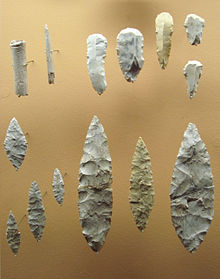
The idea of a Clovis-Solutrean link remains rather controversial and does not enjoy wide acceptance. The hypothesis is challenged by large gaps in time between the Clovis and Solutrean eras, a lack of evidence of Solutrean seafaring, lack of specific Solutrean features in Clovis technology, and other issues.
Arthur J. Jelinek, an anthropologist who noted similarities between Solutrean and Clovis styles in a 1971 study, noted that the great geographical and temporal separation of the two cultures made a direct connection unlikely. He also noted that crossing the Atlantic with the technology of the time would have been difficult if not impossible, an observation repeated by Lawrence G. Straus, who wrote that "there are no representations of boats and no evidence whatsoever either of seafaring or of the ability to make a living mainly or solely from the ocean during the Solutrean."[4] However, Straus excavated Solutrean artifacts along what is now a coastline in Cantabria, which was not coastal at the time of Solutreans, finding seashells and estuarine fish at the sites, but no evidence of exploiting deep sea resources. In addition, the dates of the proposed transitional sites and the Solutrean period in Europe only overlap at the extremes.
Another challenge to the hypothesis involves the apparent lack of cultural or artistic practices being passed on from Solutrean culture to Clovis culture, for instance the style of Solutrean artwork found at Altamira in Spain and Lascaux in France.[5] In response, Bradley and Stanford contend that it was "a very specific subset of the Solutrean who formed the parent group that adapted to a maritime environment and eventually made it across the north Atlantic ice-front to colonize the east coast of the Americas" and that this group may not have shared all Solutrean cultural traits.[6] A carved piece of bone depicting a mammoth found near the Vero man site in Florida has been dated to 13,000 to 20,000 years ago. It is described as possibly being the oldest art object yet found in the Americas, and may provide support for the Solutrean hypothesis.[7] Art historian Barbara Olins has compared the Vero mammoth carving to "Franco-Cantabrian" drawings and engravings of mammoths. She notes that the San of southern Africa developed a realistic style of depicting animals similar to the "Franco-Cantabrian" style, indicating that an independent development of such a style in North America is possible.[8]
In a 2008 study of relevant oceanographic data from the time-period in question, Kieran Westley and Justin Dix concluded that "it is clear from the paleoceanographic and paleo-environmental data that the LGM North Atlantic does not fit the descriptions provided by the proponents of the Solutrean Atlantic Hypothesis. Although ice use and sea mammal hunting may have been important in other contexts, in this instance, the conditions militate against an ice-edge-following, maritime-adapted European population reaching the Americas."[9]; taking the position that according to their analysis of the evidence they examined (primarily the believed location of the ice shelf at the time in question), they do not believe the Solutrian culture or elements of it could have undertaken any transoceanic crossing into North America utilizing the glacial ice-sheets. It is however difficult to draw any definitive conclusions from studies undertaken thus-far as the most conclusive evidence on this question would be found in coastal settlements from the time-period, but the overwhelming majority of the coastline from the time-period is now submerged under the Atlantic Ocean[10] and at present inaccessible to intensive archeological research. As such there has yet to be any reliable proof from either proponents or opponents of the theory, and it remains an unresolved issue in the field of Archeology
http://en.wikipedia.org/wiki/Solutrean
No hay comentarios.:
Publicar un comentario